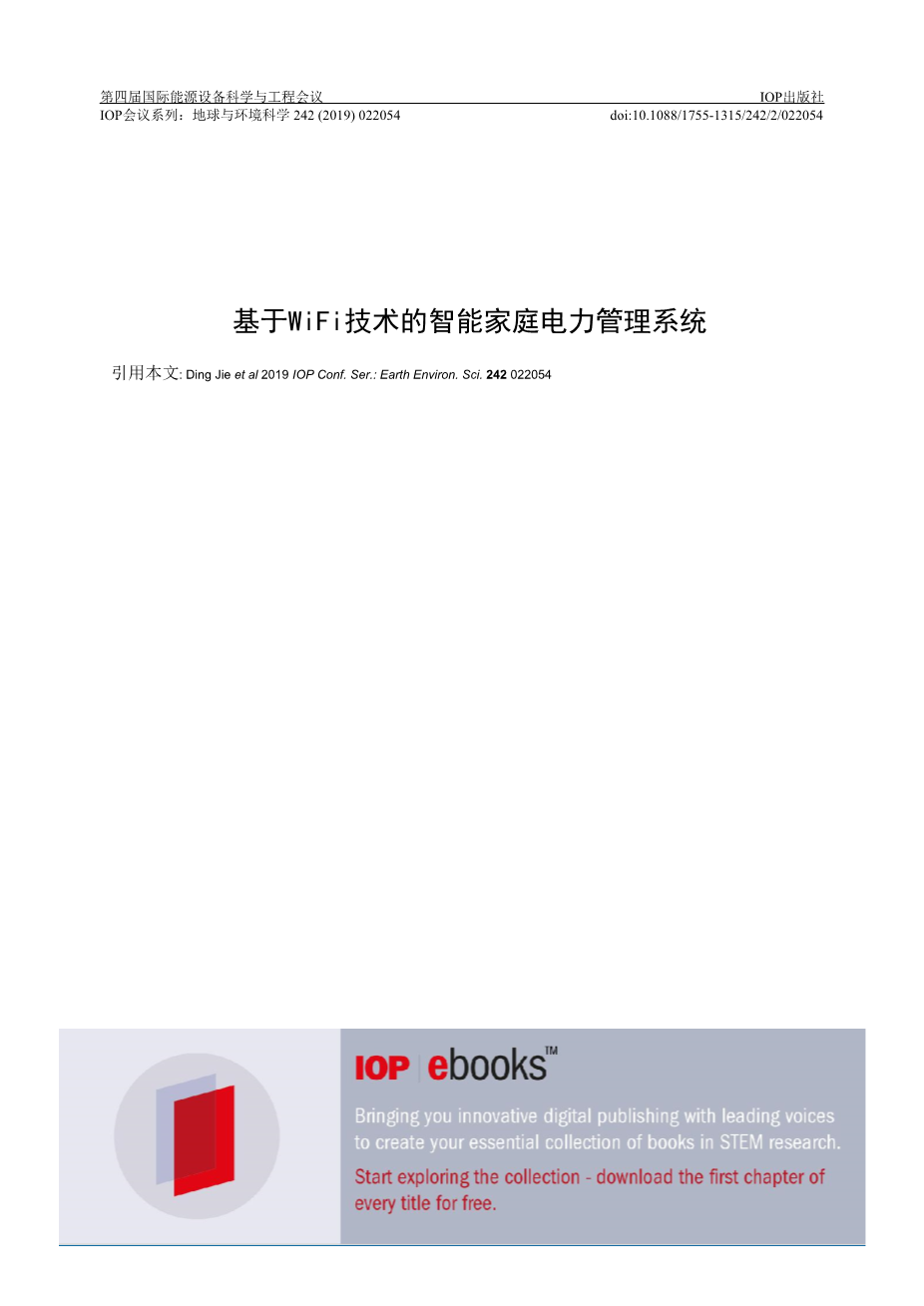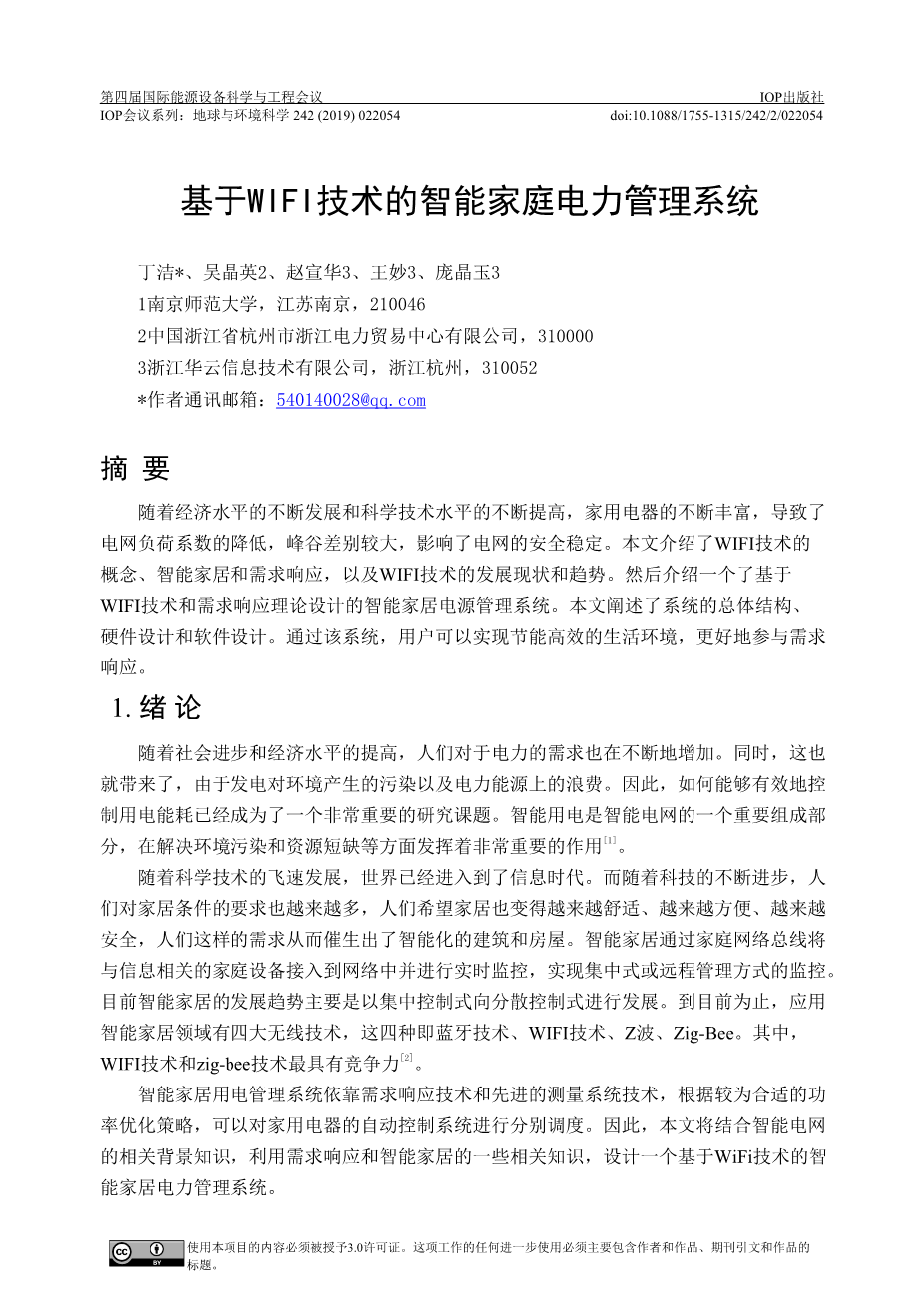IOP Conference Series: Earth and Environmental Science
PAPER bull; OPEN ACCESS
Smart Home Electricity Management System Based on WiFi Technology
To cite this article: Ding Jie et al 2019 IOP Conf. Ser.: Earth Environ. Sci. 242 022054
View the article online for updates and enhancements.
This content was downloaded from IP address 113.57.176.182 on 22/05/2019 at 13:26
Smart Home Electricity Management System Based on WiFi Technology
Ding Jie1*, Wu Jingying2, Zhao Xuanhua3, Wang Miao3, Pang Jingyu3
1 Nanjing Normal University,Nanjing,Jiangsu, 210046,China
2Zhejiang Electric Power Trading Center Co., Ltd, Hangzhou,Zhejiang,310000,China
3Zhejiang Huayun information technology Co.,Ltd,Hangzhou,Zhejiang,310052,China
*Corresponding authorrsquo;s e-mail: 540140028@qq.com
Abstract. With the continuous development of the level of economy and the continuous improvement of the level of science and technology, the continuous enrichment of household appliances has led to a decrease in the load factor of the grid and a large difference between the peaks and valleys, which affects the safety and stability of the power grid. This paper introduces the concepts of WiFi technology, smart home and demand response, as well as its development status and trends. Then, this paper designs a smart home power management system based on the theory of WiFi technology and demand response. In this paper, the overall structure of the system,the hardware design and the software design are explained. Through this system, users can achieve an energy-efficient and efficient living environment and better participate in the demand response.
Introduction
Due to the increasing progress of society and the improvement of economic level, people#39;s demand for electricity is also increasing. At the same time, it also brings about environmental pollution caused by power generation and waste of electricity. Therefore, how to effectively control electricity consumption has become an important research topic. Smart power consumption is an important part of smart grid, which plays an important role in solving environmental pollution and resource shortage [1].
With the rapid development of science and technology, the world has entered the information age. Due to the continuous advancement of technology, people#39;s requirements for household conditions have become more comfort, convenience and safety, thus giving birth to intelligent buildings and houses. Smart home connects and monitors information-related home devices into the network through the bus of the home network to implement monitoring and control for centralized or remote management. The current development trend of smart home is to control the development of a centralized to distributed control. There are currently four major wireless technologies that is Bluetooth, WiFi, Z-Wave, Zig-bee home in applied intelligence. Among them, WiFi and Zig-bee are the most competitive [2].
The smart home electricity management system relies on demand response technology and advanced measurement system technology to dispatch automatic control systems for household appliances according to suitable power optimization strategies. Therefore, this article will combine the background knowledge of smart grid, use the related knowledge of demand response and smart home to design smart home electricity management system based on WiFi technology.
Content from this work may be used under the terms of the Creative Commons Attribution 3.0 licence. Any further distribution of this work must maintain attribution to the author(s) and the title of the work, journal citation and DOI.
Published under licence by IOP Publishing Ltd 1
WiFi technology
WiFi, the full name is Wireless Fidelity, which is an 802.11b wireless network specification, is a short-range wireless transmission technology with fast transmission speed and long effective distance. WiFi usually uses 2.4G UHF or 5G SHF ISM RF band, which can be automatically adjusted with the signal when it is disturbed, and it is more reliable when ensuring network stability.
WiFi has two modes, Infrastructure mode and ad hoc mode. The infrastructure mode belongs to the traditional AP mode. In the wireless network, there is only one central point. Other nodes access the central point and exchange data through the central point. The ad hoc mode is an ad hoc network mode, and any node can communicate with other nodes without going through the center point.
Smart Home
The concept of smart home originated in the United States in the early 1980s, calling it Smart Home. It has undergone four generations of development: the first generation completes home networking through coaxial lines and two cores to achieve lighting, curtains and a small amount of security control; The second generation is through bus and IP technology networking, to be able to complete the video intercom and security business; The third generation is a centralized intelligent control system, by the central control computer to complete security, measurement and other functions; The fourth generation that is based on the Internet of things technology can be based on user needs to achieve personalized features[3].
Demand Response
Demand response (DR) is called power demand response. When the market price of power wholesale rises or system security is affected, the power company will release the signal that the electricity price rises or reduces the direct load compensation to the user, thus guiding the user to change the original habits of electricity utilization, reduce or transfer the power load, to achie


英语原文共 8 页


